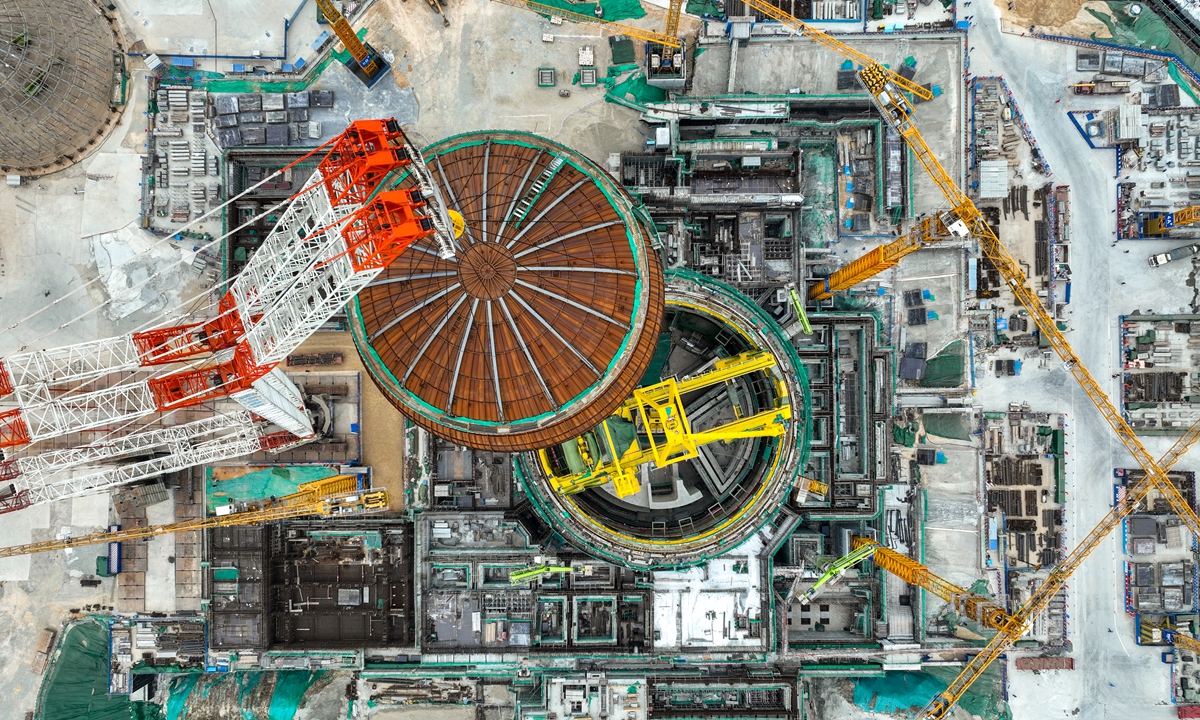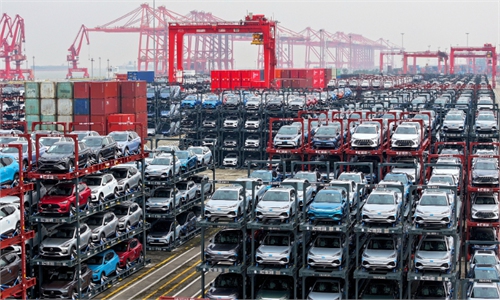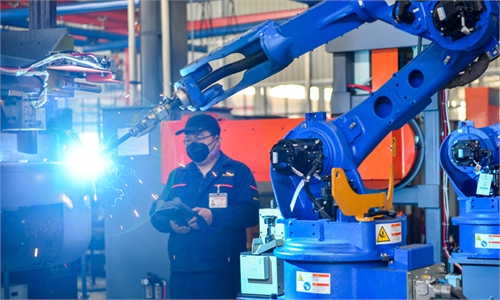Exclusive: China's nuclear energy technologies to provide energy security for more countries: national political advisor

Unit 4 of Hualong One nuclear reactor completes dome lifting and positioning at the Changjiang Nuclear Power Plant in South China's Hainan Province on December 27, 2023. Photo: VCG
Against the backdrop of nuclear energy becoming an important pillar energy for countries around the world to achieve their "dual carbon" strategic goals, the application and promotion of global nuclear energy technology are facing a new competitive landscape. At the same time, China's nuclear power plants have maintained a high record for their safety. In recent years, China has also provided many countries with "Chinese wisdom" and "Chinese solutions" for the application of nuclear energy technology.
As a new "national business card" created by China to go global, is China's nuclear power entering a "historical opportunity period"? In the future, how will China's nuclear power build international competitiveness? During this year's two sessions, Lu Tiezhong, a member of the National Committee of the Chinese People's Political Consultative Conference (CPPCC) and chairman of China National Nuclear Power Co., introduced the "international development strategy" of China's nuclear energy technology in an interview with the Global Times.
China's nuclear industry, as an important cornerstone of national security, plays a crucial role in the future energy landscape and is currently facing a new strategic development opportunity.
"Since 2021, multiple factors have resonated, leading to structural imbalances in energy supply and demand on a global scale, rapid rises in international energy prices, and phenomena such as energy shortages and power rationing in many parts of the world. Against this background, governments around the world have begun to re-examine their national energy security strategies, with major countries accelerating the adjustment of their energy security strategies, promoting diversification of energy sources, and strengthening their own supply. This new situation provides a brand-new opportunity for the global revival of nuclear energy," Lu told the Global Times.
At the same time, China has made a major strategic decision goal to achieve "peak carbon" emission by 2030 and become "carbon neutral" by 2060. It has also established a policy of actively, safely and orderly developing nuclear power. China National Nuclear Corporation (CNNC), as one of the few global companies with a full nuclear industry chain, has an irreplaceable responsibility and mission in promoting the low-carbon transformation of energy, ensuring energy security and establishing a modern energy system.
As the only enterprise group in China that has successfully exported nuclear power, CNNC has exported seven nuclear power units, seven research reactors, and one subcritical assembly to seven countries including Pakistan and Algeria, and it has established cooperation with more than 60 countries and regions worldwide, Lu said. As of now, the first batch of four Hualong One units has been completed and put into operation on schedule, and the construction of the four Hualong One units is progressing smoothly, providing the world with the Chinese solution and experience for the development of third-generation nuclear power.
At the same time, CNNC is actively promoting nuclear energy project cooperation with countries and regions such as Pakistan, Argentina, Saudi Arabia, the United Arab Emirates and Kazakhstan, striving to create more exemplary projects for the Belt and Road Initiative (BRI).
The Global Times learnt that the Hualong One, known as the "national treasure" and "national business card," is an advanced one-million-kilowatt-class pressurized water reactor nuclear power technology developed by CNNC based on more than 30 years of nuclear power research, design, manufacturing, construction, and operation experience, as well as lessons and feedback from the Fukushima nuclear accident, and the latest safety requirements in China and globally.
The Hualong One uses independently developed CF3 fuel assemblies, achieves an 18-month refueling cycle and incorporates advanced design concepts such as double-layer containment shells and resistance to large aircraft impacts, fully ensuring the safety, economy and advancement of nuclear power plants, meeting the highest international safety standards. It is also one of the most competitive third-generation nuclear power technologies globally, and has become one of the most competitive third-generation nuclear power models in the world nuclear power market.
In addition, the multi-purpose small modular pressurized water reactor Linglong One, developed by CNNC with independent intellectual property rights, started construction on July 13, 2021, in South China's Hainan Province, marking the world's first onshore commercial modular small reactor under construction, indicating that China is at the forefront of modular small reactor technology.
Lu stated that currently, many countries such as Saudi Arabia, the United Arab Emirates, Jordan, Indonesia and Thailand have shown strong interest in small reactors. At the same time, CNNC actively responded to the initiative of International Atomic Energy Agency (IAEA) on small reactors and participated in the preparation of the agency's first small reactor user requirements document, contributing Chinese wisdom to the development of modular small reactors.
"We continue to advance comprehensive cooperation with 'old friends' such as Russia and France, expand in-depth cooperation with 'new partners' such as other key European countries. We plan to establish a research and development center in Eastern Europe, seize the opportunity of accelerated global innovation resource flow and reshuffling, continuously increase the participation of international scientific and technological talents in CNNC's scientific research tasks and engineering implementation, coordinate with international development strategies, expand international influence, open up international markets and help CNNC's full industry chain 'go global'." Lu said.
Complete industry chain
As China's nuclear industry actively implements the "going global" strategy, what gives it the confidence to participate in international competition? According to Lu, the biggest advantage of China's nuclear industry lies in having a "complete industry chain."
CNNC has mastered the construction, operation and maintenance technology of the world's major reactor types, forming its own nuclear power brand. At the same time, it has accumulated a wealth of domestic and international project management and construction experience, greatly enhancing the corporation's international competitiveness.
"In terms of development scale, China currently has 55 operating units with an installed capacity of 57.3 million kilowatts, ranking second in the world. The installed capacity of units under construction has maintained the first place globally for several consecutive years. Moreover, CNNC is the only enterprise in the world that covers the entire nuclear industry chain.
From the perspective of the whole industry chain of the nuclear industry, with its overall planning to achieve balanced development, our nuclear power construction is also more confident," said Lu.
Lu believes that the independent design capability and construction level of China's nuclear power plants have entered the world's first phalanx, and the supply capacity of independent equipment has been greatly enhanced. In addition to the Hualong One and Linglong One, China also has fourth-generation high-temperature gas-cooled reactors and a new generation of "artificial sun." Nearly half of the professional technologies in fields such as nuclear reactor design and testing, uranium exploration and mining, high-temperature gas-cooled reactors, fusion reactors and nuclear engineering construction have reached international advanced levels. China's nuclear industry's scientific and technological level has shifted from lagging behind and running alongside to leading in some areas. The development of China's nuclear industry is basically in line with the country's international status.
"The current international situation is complex, and the world's political and economic landscape undergoes profound changes during the 14th Five-Year Plan (2021-25) period, which will inevitably have a certain impact on the cooperation process for enterprises. However, at the same time, opening and developing is still the trend," Lu said. He believes that the international market competition in the nuclear industry should be a dual competition of market and politics. After more than thirty years of arduous and innovative development, China's nuclear power technology now has the strength to compete on the international stage with advanced nuclear power countries. China's export of the Hualong One project to Pakistan achieved the best performance in the construction of third-generation nuclear power in 69 months, far surpassing the nuclear power design, manufacturing, and construction levels of countries such as the US, Russia and France.
As nuclear power faces a more severe international competitive situation, it is necessary for us to strengthen investment in basic scientific research, original nuclear energy technology development, and quickly achieve effective original innovation results to overall enhance China's nuclear science and technology research and development capabilities and core competitiveness, providing strong technical support for China's participation in international nuclear technology competition.
Deepening cooperation
On February 29, the International Thermonuclear Experimental Reactor (ITER), known as the world's largest "artificial sun," signed a contract for the assembly of the vacuum chamber module with a China-France consortium led by China Nuclear Power Engineering Co. under the CNNC. This marks China once again taking on the installation task of core equipment for ITER after successfully installing the "heart" device, contributing wisdom and strength to the smooth progress of the ITER project. Lu believes that this is the epitome of China's active efforts to build a global community of shared future for nuclear energy development through high-level international nuclear energy cooperation.
"CNNC actively deepens cooperation and exchanges with international organizations such as the IAEA, proposing Chinese solutions and promoting Chinese voices in global nuclear governance," Lu said. Over the past 30 years, China's nuclear power industry has developed a unique innovation capability in mastering the complexity of different types of nuclear reactors compared to its global counterparts through technological innovation and experience sharing.
In addition to providing nuclear energy technology services internationally, China's nuclear power industry continues to engage in extensive exchanges and cooperation with domestic and foreign institutions. Every year, China's nuclear power industry sends dozens of experienced experts to support the IAEA and the World Association of Nuclear Operators, making positive contributions to the sharing of experience and the improvement of technology and management capabilities in the operation and construction of nuclear power plants in various countries.
Against the backdrop of global carbon constraints, nuclear power is becoming an important means for the world to achieve carbon reduction and carbon neutrality. One of the internationalization goals of China's nuclear power industry is to promote more countries to adopt nuclear power as part of their energy supply, thereby reducing reliance on fossil fuels and enhancing energy security. Lu stated that in the future, CNNC will work with countries along the BRI to create more exemplary projects, adhere to green and low-carbon development, jointly address climate change and actively promote the construction of a global nuclear energy development community.




